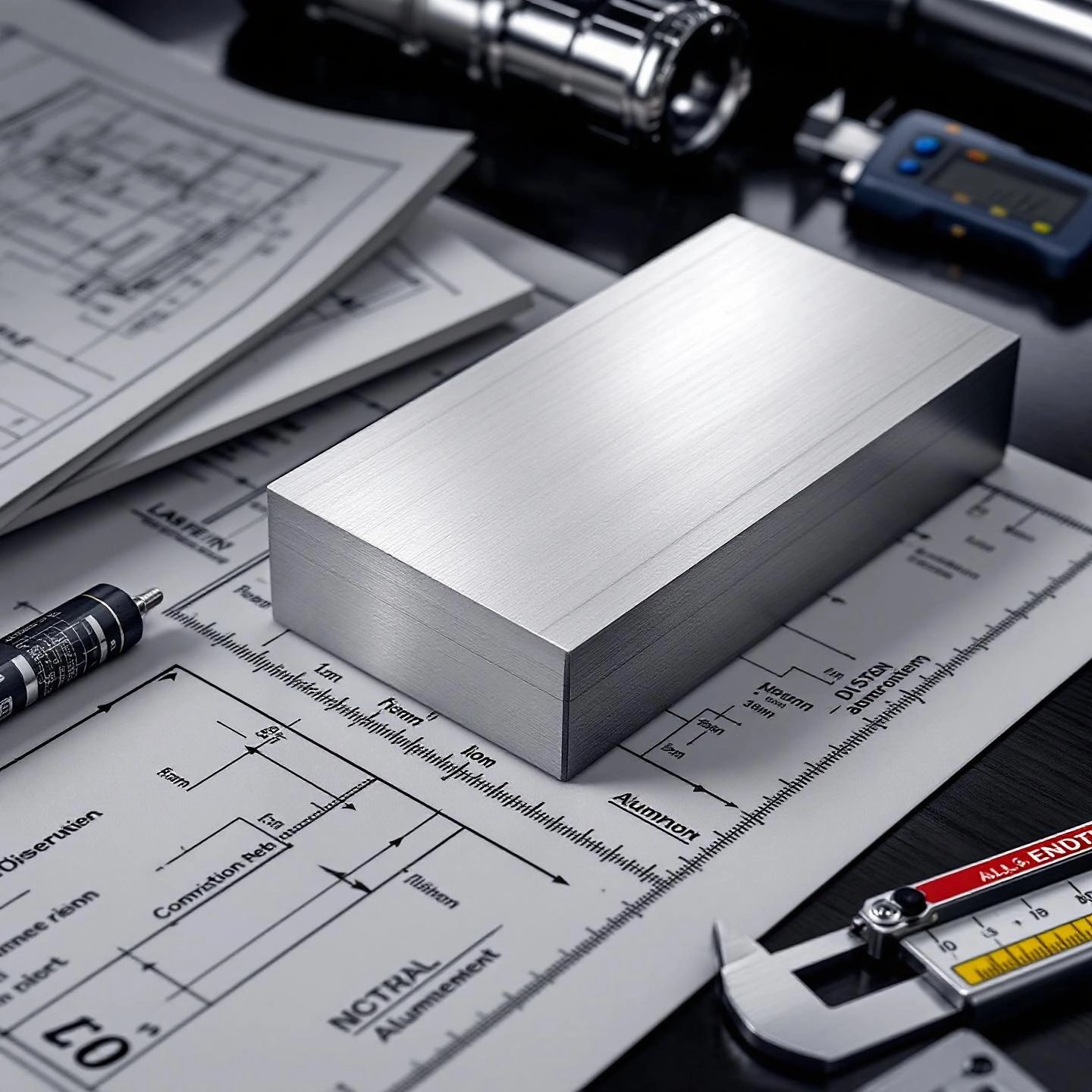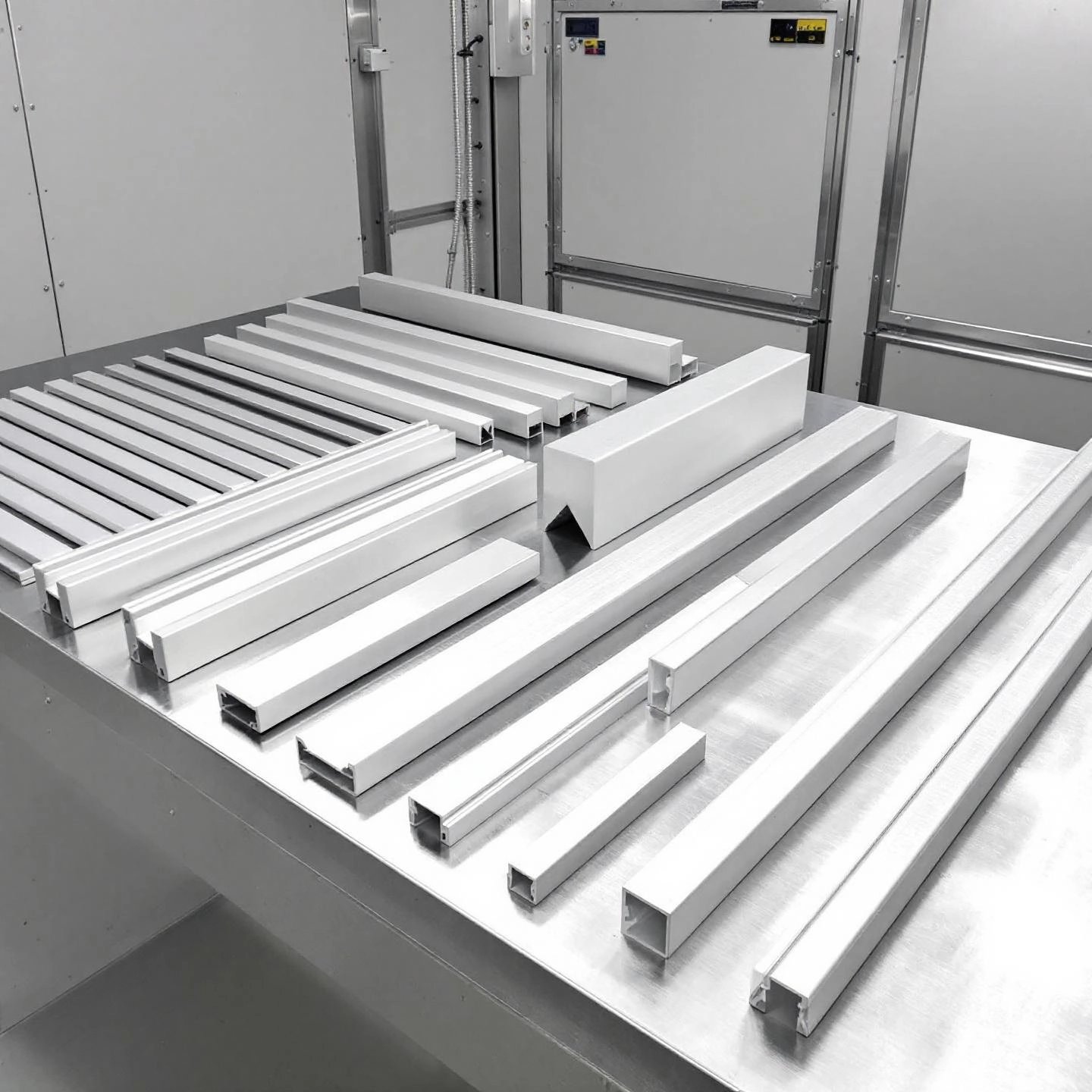
Have you ever wondered why airplanes soar so efficiently or why your car feels lighter yet remains sturdy? The answer often lies in the concept of density—a fundamental property that shapes how materials perform in real-world applications. But what exactly is density, and why does aluminum density stand out as a crucial factor in engineering?
In simple terms, density is the amount of mass packed into a given volume. Imagine two blocks of the same size—one made of wood and the other of metal. The metal feels heavier because it has more mass in the same space. Mathematically, density is calculated as:
For most materials, density is measured in grams per cubic centimeter (g/cm³) or kilograms per cubic meter (kg/m³). For example, water has a density of 1 g/cm³, while air is much less dense at about 0.0012 g/cm³ (Britannica).
Now, let’s focus on aluminum. The density of aluminum is approximately 2.7 g/cm³ (or 2,700 kg/m³). This value is widely accepted as the benchmark for pure, unalloyed aluminum. Compared to other metals like steel (which can be three times denser), aluminum’s lightweight nature is immediately apparent.
Aluminum’s relatively low density is more than just a number—it’s a game-changer for industries that demand high performance and efficiency. Here’s why:
Because of these advantages, aluminum is often the material of choice for engineers and designers aiming to optimize performance, reduce costs, and meet sustainability goals. Its density also plays a role in heat transfer, electrical conductivity, and corrosion resistance—further broadening its appeal.
This blog post will walk you through:
For a deeper dive into specific values, alloys, and practical examples, check out this blog by Shengxin Aluminum for a comprehensive guide.
Ready to explore how aluminum density shapes the future of engineering? Let’s dive in.
When you’re selecting materials for a project, the pure aluminum density is often one of the first numbers you’ll check. But what exactly is the standard, and why does it matter so much for engineers and manufacturers?
The aluminum density standard for pure, unalloyed aluminum is universally recognized as 2.70 grams per cubic centimeter (g/cm³) or 2,700 kilograms per cubic meter (kg/m³). This value is set by leading industry organizations and is used as a baseline for calculations, material selection, and engineering design around the world.
To put this in perspective, aluminum is about one-third the density of steel, making it exceptionally lightweight for its strength. This property is why pure aluminum—and its alloys—are so widely used in fields where reducing weight is critical.
The density of pure aluminum serves as a trusted benchmark for engineers. Whenever you need to estimate the mass, shipping costs, or structural properties of aluminum components, this standard value provides a reliable starting point. It’s also the foundation for comparing the densities of aluminum alloys, which can vary slightly based on additional elements like magnesium, silicon, or zinc.
You might wonder: does this number ever change? In practical terms, the density of pure aluminum stays remarkably consistent. However, minor factors can cause negligible variations:
In summary, the pure aluminum density of 2.70 g/cm³ (2,700 kg/m³) is the gold standard for engineers and designers. It’s the value you’ll use to calculate weights, design structures, and compare materials with confidence. Next, let’s explore why aluminum’s low density is such a game-changer for modern industries.

Imagine you’re tasked with designing an airplane wing or a lightweight car frame. What’s the first material property you’d consider? For most engineers, the answer is simple: density. But why does low density matter so much, and what makes aluminum stand out from the crowd?
Aluminum’s density is about one-third that of steel or copper, making it one of the lightest structural metals available. This unique property unlocks a host of advantages across industries, largely due to the material’s exceptional aluminum strength to weight ratio. In other words, aluminum delivers impressive strength without the burden of extra mass.
Sounds complex? Let’s break it down with practical examples:
So, what are the core benefits of low density aluminum that engineers and manufacturers value most?
Leading manufacturers, such as Shengxin Aluminum, harness the unique properties of aluminum to deliver high-performance profiles for industries where weight reduction is mission-critical. Whether it’s producing advanced rail transit components, lightweight automotive parts, or innovative building systems, these companies rely on aluminum’s low density to help clients achieve greater efficiency, safety, and design freedom.
When you choose materials for your next engineering project, remember: the right balance of strength and weight isn’t just a technical detail—it’s the foundation for innovation and long-term success. Up next, we’ll show you how to calculate aluminum’s density in imperial units, making it easy to apply these concepts to real-world design challenges.
When you’re working on a project in the United States or with blueprints that use imperial measurements, understanding aluminum density lb/in3 is essential for accurate planning and cost estimation. But what does this value mean in practice—and how do you use it to determine the weight of your aluminum parts?
The standard density of aluminum in imperial units is 0.0975 pounds per cubic inch (lb/in³). This value is commonly referenced for both pure aluminum and the widely used 6000-series alloys, making it a reliable baseline for calculations.
Sounds complex? Let’s break it down with an easy, actionable example. Imagine you need to find the weight of a solid aluminum block for a structural support, and you have the following dimensions:
Here’s how you’d perform the aluminum weight calculation in imperial units:
This means your aluminum block would weigh approximately 7.8 pounds.
Weight (lb) = Length (in) × Width (in) × Height (in) × 0.0975
Using this straightforward approach, you can estimate the mass of any aluminum component—be it a sheet, bar, or custom extrusion—without needing advanced tools or calculations. This method is especially helpful for engineers, fabricators, and procurement teams who need fast, reliable answers on the shop floor or during project planning.
Next, we’ll shift gears to the metric system, showing how aluminum density is expressed and calculated in kg/m³ for international and scientific applications.
When you’re collaborating on international projects or reviewing technical datasheets, you’ll notice that aluminum density is almost always listed in the metric system. But why is this the global standard, and how do you confidently interpret these values?
The most widely accepted aluminum density metric value is 2,700 kilograms per cubic meter (kg/m³). This figure is recognized across engineering, manufacturing, and scientific communities as the baseline for pure aluminum. Whether you’re specifying a material for aerospace, automotive, or construction applications, this number is your starting point for calculations and comparisons.
Sounds complex? It’s actually straightforward. Aluminum’s density is often given as 2.70 g/cm³ in some references, but converting to kg/m³ is simple:
This means the metric and SI units are directly interchangeable, making it easy to switch between them depending on your project’s requirements.
Imagine you’re working with teams from Germany, Japan, or Brazil. Using aluminum density kg/m3 ensures everyone is speaking the same language—reducing confusion and streamlining communication. Here’s why the metric system is preferred:
In summary, knowing that the standard aluminum density metric value is 2,700 kg/m³ empowers you to design, specify, and compare materials confidently—no matter where your project takes you. Next, we’ll look at how density can change slightly in popular aluminum alloys, such as 6061, and why these differences matter for engineering precision.

When you’re comparing materials for your next engineering project, you’ll likely come across 6061 aluminum—one of the most popular and versatile alloys in the aluminum family. But what makes the 6061 aluminum density so reliable, and why is it a trusted choice for everything from aerospace components to consumer products?
Let’s start simple. The typical aluminum alloy density for 6061 is 2.70 g/cm³ (or 0.0975 lb/in³). This value is essentially the same as pure aluminum, which means you get the advantages of alloying—like higher strength and corrosion resistance—without a significant increase in weight. That’s a big deal when every gram counts in your design (ASM MatWeb).
So if you’re used to working with pure aluminum, you’ll notice that switching to 6061 alloy doesn’t disrupt your calculations or project planning. This consistency is one of the reasons 6061 is a go-to material for engineers worldwide.
Sounds complex? Here’s the good news: the density of 6061 aluminum remains remarkably stable, even with the addition of alloying elements like magnesium and silicon. These elements are chosen precisely because they enhance mechanical properties—like strength and weldability—without adding much weight. In fact, the difference in density between pure aluminum and 6061 alloy is so slight, it’s usually negligible for most engineering calculations.
Imagine you’re designing a lightweight structure where every detail matters. Even a small variation in density can affect weight calculations, structural integrity, and long-term performance. That’s why engineers and procurement teams often emphasize the importance of sourcing 6061 aluminum from trusted manufacturers.
In summary, the 6061 aluminum density offers the perfect balance of lightweight performance and structural reliability. By choosing high-quality, precision-processed materials from established manufacturers, you ensure that your designs deliver the performance and consistency your industry requires. Next, let’s take a closer look at how tempering—such as the T6 process—affects (or doesn’t affect) the density of 6061 aluminum, so you can make even more informed material choices.
When you see the term 6061-T6 aluminum on a datasheet, what does it really mean—and does the tempering process impact its density? Let’s break down this concept so you can make smarter material choices for your next project.
Imagine you’re working with a standard 6061 aluminum alloy. To enhance its mechanical properties, manufacturers use a process called tempering. The T6 designation refers to a specific heat treatment sequence: the metal is solution heat-treated, rapidly quenched, and then artificially aged. This process is designed to maximize strength and hardness, making 6061-T6 ideal for demanding structural applications.
Here’s a common question: does all this heating and cooling affect the 6061-T6 aluminum density? The answer is simple—the density remains virtually unchanged after tempering. While the T6 process alters the internal structure to boost strength and hardness, it doesn’t significantly change the mass or volume of the material. As a result, 6061-T6 aluminum retains the same standard density as its untempered form—about 2.70 g/cm³ (or 0.0975 lb/in³).
So, when you specify 6061-T6 aluminum, you gain superior strength and durability—but you don’t have to worry about density fluctuations affecting your designs. Next, we’ll compare the densities of 6061, 7075, and other metals to help you select the best material for your engineering needs.
When you’re choosing materials for high-performance projects, you’ll often find yourself weighing the pros and cons of different alloys and metals. Ever wondered why a bicycle frame, an aircraft part, and a skyscraper beam might all use different materials—even if they look similar? The answer often comes down to density and how it impacts strength, weight, and cost.
Let’s start with two of the most widely used aluminum alloys: 6061 and 7075. While both are prized for their strength and versatility, their densities differ slightly—and that small difference can have a big impact on design decisions.
So, when you need maximum strength for things like aircraft fittings or high-stress mechanical parts, 7075 might be your go-to. But if low weight and excellent workability are your priorities, 6061 is often the better fit.
To put aluminum alloys in perspective, let’s compare them with other common engineering metals. You’ll notice that even the densest aluminum alloys are far lighter than steel or titanium—an advantage that can’t be overstated in weight-sensitive applications.
| Material | Density (g/cm³) | Density (kg/m³) | Key Applications |
|---|---|---|---|
| 6061 Aluminum | 2.70 | 2,700 | Structural components, automotive frames, marine, electronics |
| 7075 Aluminum | 2.81 | 2,810 | Aircraft fittings, military, high-stress parts |
| Titanium | 4.50 | 4,500 | Aerospace, medical implants, sports equipment |
| Steel (Carbon) | 7.85 | 7,850 | Construction, automotive, tools |
| Stainless Steel | 7.75–8.10 | 7,750–8,100 | Medical devices, kitchenware, chemical tanks |
As you can see, the difference in aluminum vs steel density is dramatic—steel is nearly three times heavier than aluminum alloys. This is why aluminum is the material of choice for applications where every ounce matters, such as in aerospace and automotive design. Titanium, while denser than aluminum, is still much lighter than steel and offers a superior strength-to-weight ratio, making it popular for high-performance and specialized parts.
So, how do these numbers shape your material selection?
Imagine designing a drone: every extra gram means shorter flight times. That’s why understanding the subtle differences in density—especially between alloys like 6061 and 7075—can make or break your design’s success. Next, we’ll explore how aluminum’s density compares to its oxide, and why this matters for surface treatments and protection.

Ever wondered what happens to aluminum when it’s exposed to air—or why its surface often looks slightly different from the shiny metal underneath? The answer lies in the formation of aluminum oxide, a compound with properties that are crucial for both engineering and everyday use. But when it comes to aluminum vs aluminum oxide, how do their densities compare, and why does this matter?
Let’s start with the numbers. The density of pure aluminum is about 2.70 g/cm³, as covered earlier in this guide. In contrast, aluminum oxide density (Al₂O₃) is significantly higher—typically around 3.95 g/cm³ (Wikipedia). That means for the same volume, aluminum oxide is much heavier than metallic aluminum. This difference is due to the tightly packed crystal structure of Al₂O₃, which is even denser than most aluminum alloys.
You might ask: why should engineers care about the difference between these two densities? Here’s why this distinction is important:
Imagine you’re designing a component that needs to resist wear and corrosion—like a bicycle rim or architectural panel. By leveraging the high-density, hard aluminum oxide layer, you ensure the part lasts longer and performs reliably, even in harsh environments. This is why surface treatments that increase the oxide layer are standard practice in industries where durability and longevity are critical.
Understanding the difference between the density of aluminum and its oxide helps you make better choices about materials, surface treatments, and long-term performance. As we wrap up this guide, let’s recap the key takeaways about aluminum density and its vital role in engineering innovation.

When you step back and look at the big picture, it’s clear why aluminum density for engineering is such a foundational concept. Throughout this guide, we've explored the standard value for aluminum density—about 2.70 g/cm³ or 2,700 kg/m³—and seen how this property underpins everything from material selection to finished product performance (Shengxin Aluminum).
Imagine designing a component where every gram counts—whether it’s an aircraft wing, an electric vehicle chassis, or a modular building frame. Consistent, reliable density data is the backbone of safe, efficient, and innovative engineering. That’s why sourcing from a trusted aluminum profile manufacturer is so important. Partners like Shengxin Aluminum combine advanced production techniques with rigorous quality control, ensuring every profile or extrusion meets exacting standards for density and performance.
As you plan your next project—whether it’s a high-speed rail component, a solar panel frame, or a custom machine enclosure—remember the pivotal role of aluminum density in engineering success. By leveraging this knowledge and collaborating with expert manufacturers, you set the stage for innovation, reliability, and long-term value in every application.
Ready to take the next step? Consider consulting with a proven aluminum profile manufacturer like Shengxin Aluminum to ensure your designs achieve the precision, consistency, and performance your industry demands.
Aluminum has a standard density of about 2.70 g/cm³ (2,700 kg/m³), making it much lighter than steel and ideal for applications where reducing weight is crucial, such as in aerospace and automotive engineering.
The density of 6061 aluminum alloy is approximately 2.70 g/cm³ (0.0975 lb/in³), nearly identical to pure aluminum. This consistency makes it a reliable choice for structural and precision components across many industries.
Aluminum's density in imperial units is about 0.0975 lb/in³. This value is commonly used for calculations in the US and is relevant for both pure aluminum and common alloys like 6061.
Aluminum is much less dense than steel, with steel's density around 7.85 g/cm³ and titanium at 4.50 g/cm³. This low density gives aluminum a major advantage in weight-sensitive engineering applications.
Tempering processes like T6 and alloying elements have minimal impact on aluminum's density. They primarily enhance strength and hardness, so the material remains lightweight while gaining improved mechanical properties.
 online service
online service 0086 136 3563 2360
0086 136 3563 2360 sales@sxalu.com
sales@sxalu.com +86 136 3563 2360
+86 136 3563 2360